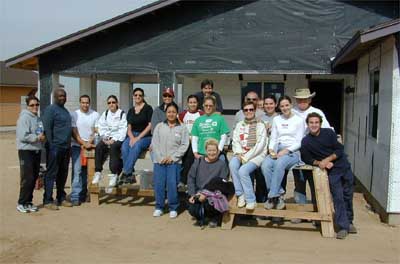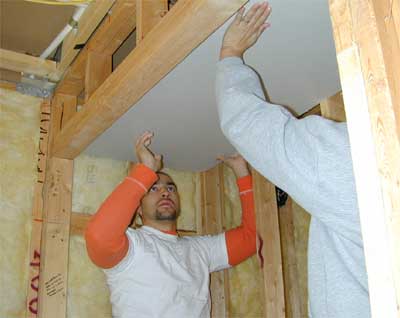![]()
Habitat for Humanity

(Class Photo)
I thought I knew a few things about Habitat for Humanity before we were given the assignment of volunteering for a morning. Our class was assigned to the Villas Esperanza community that is located on 15th avenue, south of Southern Avenue. Some of the things I believed turned out to be true and some did not. I thought of Habitat for Humanity as a charitable organization that built houses for the poor. I thought former President Jimmy Carter created it. I thought that anyone could get a home from them if they were below the poverty line and willing to work on the home themselves. I thought helping out would be a lot of fun.
When I was younger I did a little construction work for my uncle. I was hoping that the work we were going to do for Habitat would be the same. I was happy we were going to be hanging drywall because I wanted to be able to feel like I had done some "real" work on the house. By the end of the four hours, though, I was tired. I had been thinking of hanging drywall on the walls, not the ceiling! When we were done I definitely felt like I had been given the chance to do some "real" work on the house.
The foreman of the job, Romeo, was really motivated. He obviously knew that he
had to get as much work out of as he could in the limited amount of time that we
were there. Romeo reminded me of a good football coach, floating from group to
group, giving directions, keeping the work moving and motivating the workers.
You really have to respect a man who can do all of that at 71 years of age.

After the work was completed we saw a home that was almost ready for the new owners to move in. This gave us some time to learn more about the program. I found out that a home cost about $60,000 in materials and $15,000 in land. Homeowners are expected to work on building other homes before they are given the opportunity to pick a lot and home features for their own home. The owner agrees to stay for 20 years and to pay an additional $20,000 penalty if they leave before that time is up. If they stay, they only repay the $75,000 cost of the home. That makes the loan interest free!
Because the idea is to get as many people into homes as possible, the homes are
pretty basic. No fancy vaulted ceilings, no upgraded tile and no arched
doorways. One of the things I was wrong about is that anyone can get a home from
Habitat for Humanity. In fact, a lot fewer people can qualify than I expected.
The process used to select homeowners seemed pretty tough. Habitat is not
helping the destitute but rather the working poor. Potential owners must have
good working histories and the ability to pay for their mortgage.
I leaned a few more things when we went to see the Habitat community on 16th Street. It turns out that Phoenix was the first Habitat group to come up with the idea of creating an entire community of homes for the working poor. Up until that project, Habitat only built a few homes in each spot. I also learned that Jimmy Carter wasn’t the founder of Habitat but only an advocate of the program. Regardless of his role, I believe his contributions to the program are immeasurable
I learned a lot about Habitat that day. I was lucky enough to meet some outstanding people, like Romeo and get a close up look at the good work that can be created by people who care. To learn more click here www.Habitataz.org
Chris Fowler